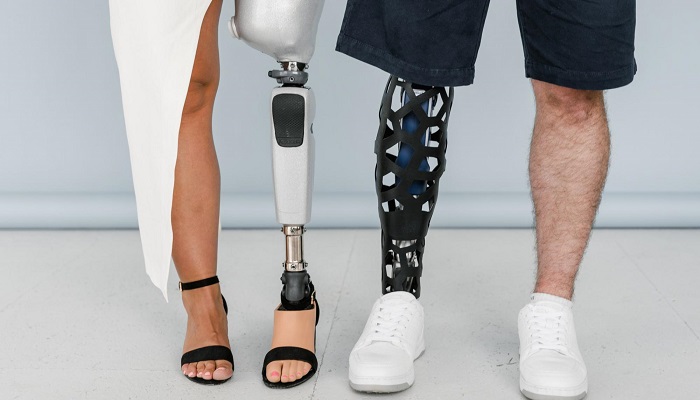Different prosthetic devices are used in different situations and it’s important to understand the differences among them to make the right choice. There are 4 main types of prosthetics:
- Transradial — Artificial arms attached below the elbow.
- Transfemoral —Artificial legs attached above the knee or around the thigh.
- Transtibial — Artificial legs attached below the knee.
- Transhumeral — Artificial arms attached below the shoulder but above the elbow.
Apart from these, some other kinds might be used in specific conditions. Custom prosthetics solutions also exist to tackle specialized requirements.
What are transradial prosthetics?
The transradial prosthetic is a type of artificial hand that is attached right below the elbow. These are typically used for amputees who have lost their arms above the elbow.
Transradial prosthetics are designed to fit over the shoulder and elbow. They are often used by people who have lost a hand or arm in an accident or due to illness and usually don’t require a lot of rehabilitation. There are also passive transradial prosthetics – artificial arms that don’t grab or perform actions but are purely for cosmetic purposes.
These patients may also have a partial hand or fingers that can be controlled by electrical impulses from the brain, making it possible for them to perform some tasks such as writing or holding a cup of coffee.
The TR prosthetic is a transverse, or across-the-arm device that crosses the carpometacarpal joint and attaches to the ulnar styloid process of the radius.
It is a very common type of prosthetic for upper extremity amputees because the hand has a natural movement pattern and balance system in place. This means that there is less need for training in order to use it. In addition, it provides more flexibility than other types of prosthetics as it allows for greater movement of the wrist, fingers, and thumb.
What are transfemoral prosthetics?
Transfemoral prosthetics are artificial limbs that replace the leg. They are usually made of metal and plastic, with a socket for the foot and shin.
They are designed to be positioned in the upper thigh area, where the femur bone is located. The prosthetic foot can be attached to this leg through a socket and ankle cuff system. A knee joint is usually included in this type of device as well.
Generally, this is the hardest type of prosthetic to pull off and requires extensive rehabilitation. Once successful, however, it allows the person to move seemingly normally.
The strength of the residual limb above the knee controls the artificial knee joint through the hip motion in this case.
What are transtibial prosthetics?
Transtibial prosthetics are artificial limbs that replace the lower part of both legs, typically below the knee. As the knee can already provide sufficient movement, transtibial prosthetics don’t provide much motion assistance but rather, focus on comfort and balanced weight distribution.
Walking with a transtibial prosthetic leg can be challenging and will very likely require rehabilitation. These artificial limbs often don’t move as they lack motion assistance. One has to learn to walk with a transtibial prosthetic limb over time.
What are transhumeral prosthetics?
Transhumeral prosthetics are artificial limbs that replace the upper part of both arms. These prosthetics replace an arm or hand and upper body functions such as movement, grasping, and typing.
They may include hand attachments for gripping objects and wrist articulation for turning knobs and opening jars. Transhumeral prosthetics are designed to be worn above the elbow on the shoulder.
As the elbow is missing to control motion, a transhumeral artificial arm is more difficult to control and get used to compared to prosthetics that are connected to the shoulder or the elbow.
Are orthotic services a good replacement for prosthetics?
Orthotic services and prosthetic devices can be used in place of a real leg if there is no other option. Orthotics are used to treat a number of conditions, including arthritis and other joint problems.
They can help relieve pain and increase mobility by providing support. Some people use orthotics as a temporary solution while they wait for a new prosthesis, while others use them as daily wear. There are many types of prosthetic legs available, including Knee-Walker or Segway, or Ankle-Foot Prosthesis (AFP).
Orthotics are a good alternative to prosthetics. Orthotics are designed to help restore stability, function, and comfort in the foot, ankle, and leg. While they can provide relief in many areas of the body, orthotics can’t provide the same level of support as a prosthetic leg.
What are the different types of prosthetic legs?
There are many different types of prosthetic legs available on the market today. The most common types include hamstring/knee braces, which are used to support the knee joint; lower limb amputation supports, which stabilize the ankle; and above-knee amputation supports, which stabilize the knee.
In addition to these common prosthetic leg types, there are also several custom-made options available for people with specific needs such as those who have undergone multiple surgeries or those who have had their bones replaced with metal components.
Wrapping up
Prosthetics are devices that replace lost or damaged body parts. There are many different types of prosthetics, but they all work in the same way: They help you move your body as if you have a natural limb.
Knowing the different types of prosthetics and how they differ is crucial before you decide what works best for you.


















